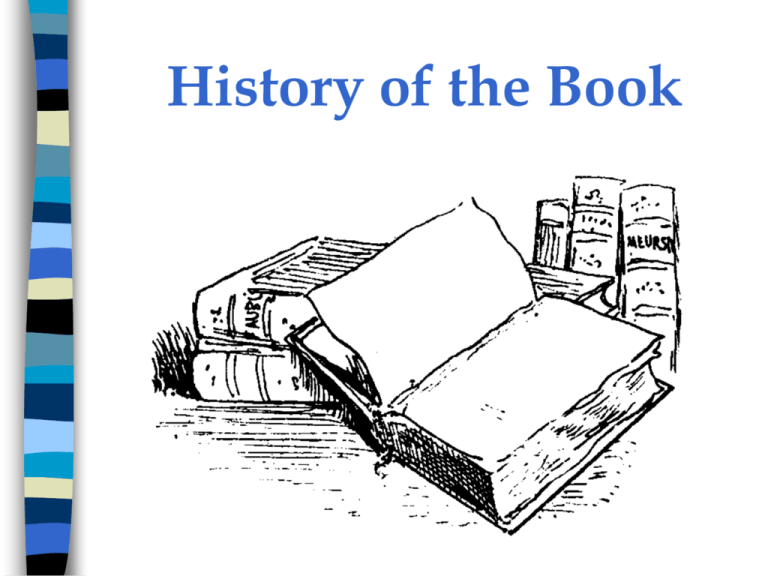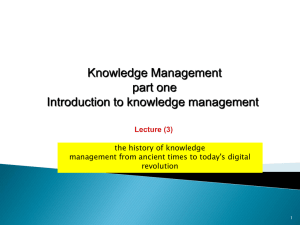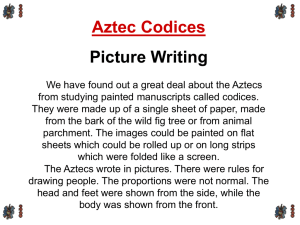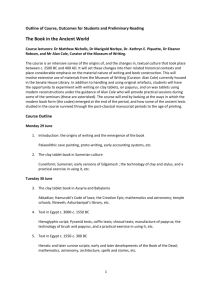History of the Book
advertisement

History of the Book If books had been invented after the computer, they would have been considered a big breakthrough. Books have several hundred simultaneous paper-thin, flexible displays. They boot instantly. They run on very low power at a very low cost. Professor Joseph M Jacobson, MIT Media Lab, quoted in the N. Y. Times, April 8, 1988 The history of the book reflects the history of civilization. The earliest type of “written” communication used pictures, such as those found on cave walls. Around 3500 BCE the ancient Sumerians created the first true written language called “cuneiform,” which means “wedge-shaped.” The Sumerians also created the first permanent and portable documents by writing on clay tablets, which were then dried so they became permanent records. Around 2700 BCE the Egyptians developed a way to make sheets of writing material from the papyrus plant Because the papyrus was brittle, it was rolled into scrolls for storage. These scrolls are considered the first true books. In Ancient India and Southeast Asia, books were written on palm leaves bound together with string. The ancient Greek and Romans often used wax tablets and a stylus for personal correspondence and business records These “pages” could be erased by smoothing out the wax. The Chinese invented paper, which unlike papyrus, could be easily folded. This led to the development of the concertina (or accordion) format. The ancient Aztecs also created books using the accordion format. This illustration shows players on a ball court. Around 300 CE, the Romans began linking together wooden tablets using cords. They called this a codex, from the Latin caudex, or “tree trunk.” We now use the term codex to refer to any book made of folded and sewn signatures. Since the codex was invented, many different styles have evolved. The codex has advantages over other book forms The size can be adjusted for very long texts or several shorter texts can be bound together in one volume It makes more efficient used of materials since both sides of the page can be used The codex has advantages over other book forms The codex is portable an easy to store The use of individual pages allows for varied layouts and the inclusion of large illustrations Because the writing surface is not rolled up, a wider variety of decorating techniques can be used Later, papyrus – and then parchment made from sheep or calf skin – replaced the wax tablets and the pages were stitched together. During the Middle Ages, books, especially the Bible, were hand-copied by monks in a scriptorium. Many of these books contained beautiful miniature paintings called illuminations. Around the 3rd century CE, the Copts, early Christians living in Egypt adapted a chain stitch to to bind sections between wooden covers. This style is now called Coptic binding. Japanese stab binding uses an awl or punch to create the holes for the thread. The pamphlet stitch is a simple way to bind one section of folios. Pages can be folded and glued to make a star or butterfly book. Using traditional forms and modern innovations, today’s book artist creates a synthesis between books and fine art. www2.truman.edu/~capter/ jins343/cave.htm www.usu.edu/.../writing_medium/ optimized/cuneiform.jpg www.jmu.edu/foundation/Collection/ cuneiform.jpg www.geschenkzeitung.de/deutsch/ images/wissen/papyrus.jpg www.georgetown.edu/labyrinth/ images/scribe.gif http://www.swu.ac.th/hu/lib-sci/ifla99/books.html graduate.gradsch.uga.edu/ archive/Greek.html archterra.cilea.it/exhibits/gold/ sources/contracts/c6_1.jpg www.holt-wilson.freeserve.co.uk/ vellum1U.jpg jrider.web.wesleyan.edu/.../2001f/ fren234/01/icelan27.jpg www.doyle.com.au/images/ kells8 www.inventions.org/culture/ ancient/mexican.html








